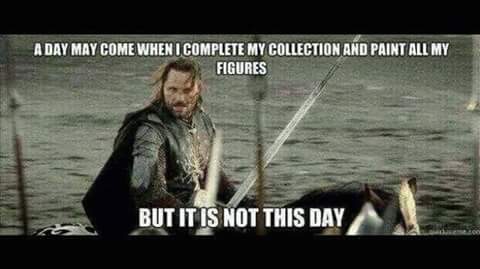As the Russian forces pile onto the table in left-center, the battle reaches a critical point on the right. The French have boldly attacked and the Prussians, with equal daring have charged home with the bayonet. The melees swung to and fro until one Prussian unit broke. Cavalry formed the Prussian riposte.
The French and Prussians locked in deadly melee. The card on the table indicates which side has the move option, as well as another card later for shooting.
Meanwhile the French methodically closed on the center. Their ranks unusually quiet and grim.
The French are everywhere! Even on the far right a converged grenadier element forces the detachment of some Prussian grenadiers to deny them our flank. Numbers told and we lost this element and the bridge.
The von Kleist Horse Grenadiers move to support the right. They ended up, after much maneuvering, crashing into a pursuing French unit and routing it.
The Cossack Hetman, Taras Shevchenko (center figure on the green stand) had come along on the expedition to determine the suitability of the ground and, um.... resources before bringing his forces into play. Here he interrogates a Prussian train driver about the contents of his pouch.
The Russian cuirassiers move to the right side of center, judging that to be the more critical flank. Little did we know that the usually victorious Prussian cavalry on the far left, engaged for three long melees with the Austrian and French heavies would fail to win. While they did not rout, the mandatory disengagement required Russian infantry be held back to protect against cavalry incursions. Infantry we planned to use to drive back the enemy.
The grenadier battalion found itself facing off against two enemy battalions and a gun so while disappointing, their rout was not totally unexpected. What will the Grand Duke say when he learns?
Our six pounders come into action while artillery Colonel Krontsteen looks on. The marker at the base of the artillery section denotes ammunition available. Roundshot and cannister.
The Russian Cuirassiers, Dragoons and Horse Grenadiers prepare the master counter stroke against the French. Alas, with the Prussians severely weakened everywhere we never had the opportunity to attack. At the end of the game, both sides had exhausted their cavalry on the left and the infantry had been ground to a halt by the fresh Russians. In the center our forces were hanging on, though many units were mere shadows of their starting strength. And on the right we judged the French victorious, though they had nothing left to exploit their advantage. The consensus of players was that the Russo-Prussian force would slowly withdraw with no pursuit from the exhausted French and Austrians.
Another spectacularly fought battle, as always the supreme visual treat to see so many large-scale and magnificently painted figures together. Thanks to all for their inspired and gentlemanly play. Till next time, or as my Prussian allies might say, "Wir warten."
